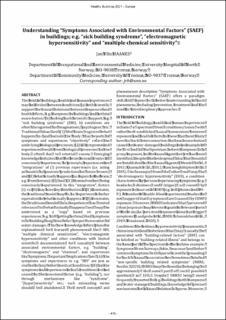| dc.description.abstract | The field of buildings, health and human experiences may be divided between conditions (a) with scientific support for causal relations between exposure and health effects, e.g. dampness in buildings and asthma exacerbation; (b) lacking such scientific support, e.g. “sick building syndrome” (SBS). b) conditions are often disregarded as imaginations, psychogenic etc. Traditional ideas are (1) the brain registers what happens in- and outside the body, thus reports of symptoms and experiences “objectively” reflect the underlying biological processes; (2) all symptoms and experiences result from biological processes in the body, often due to external causes. Emerging knowledge indicates that the brain instead creates all consciously experiences. In principle, experiences are “integrations” of (I) previous experiences (i.e. acting as models to generate predictions on future events) and (II) what actually happens (i.e. inputs to the brain, e.g. from senses); (I) and (II) themselves not being consciously experienced. In this “integration”, factors (I) vs. (II) may have any distribution. If (II) dominates, the traditional model may fit, i.e. experience is rather equivalent to what actually happens. If (I) dominates, the traditional model fails, experience has limited relevance to what actually happens and may be understood as a “copy” based on previous experiences; e.g. still getting asthma(like) symptoms in a building long time after proper renovation of water-damages. This new knowledge offers plausible explanations for learned phenomena like SBS, “multiple chemical sensitivities”, “electromagnetic hypersensitivity” and other conditions with limited scientific documentation for causality between associated environmental factors, e.g. “building”, “electromagnetic” and “chemical”, and experiences like symptoms. Important implications are (A) the symptoms and experiences in e.g. “SBS” are just as real as in any other medical condition; (B) as the symptoms and experiences in such conditions are not caused by the associated factor (e.g. “building”), nor through mechanisms like “syndrome”, “(hyper)sensitivity” etc.; such misleading terms should be abandoned. The new concept and phenomenon description “Symptoms Associated with Environmental Factors” (SAEF) offers a paradigm shift. SAEF opens for a better understanding of such phenomena, including prevention, treatment and the need for interdisciplinary approaches. | |

